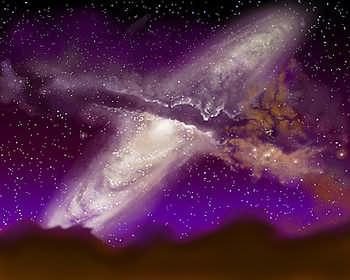Billions of years from now, the Milky Way will look totally different, as pictured to the left. When you look up at the sky, you may see another entire galaxy passing through the plane of our own, creating stars and supernovae and changing the entire sky.
Though most galaxies are rushing away from us as the Universe expands, Andromeda and the Milky Way are orbiting each other and closing in fast. Collisions between galaxies aren’t always catastrophic (the Milky Way is colliding with the Canis Major Dwarf galaxy right now, swallowing its stars up into the galactic disk), but they can trigger star formation on large scales and increase the number of supernovae.
When the galaxies collide, there is little chance that many stars will slam into each other directly because they are so spread out; however, the gas that lies between the stars can collide, heat up and trigger the formation of new stars. This interstellar gas and dust could also get sucked up by existing stars, increasing their mass to the point where they go supernova.
By the time the Milky Way and Andromeda collide, though, much of the gas in both galaxies will have been used up to create stars, so a “starburst” won’t happen. It won’t be a quick merger, though, and the spiral structure of each will be seriously changed. As you can see in this animated simulation from University of Toronto astronomer John Dubinski, the galaxies will pass through each other a few times, and the gravitational disturbance of this passage will throw stars willy-nilly into empty space.
Andromeda and the Milky Way will pass through each other once, then fall apart for about a billion years, then pass again, and again until finally settling down to merge completely about 5 billion years from now. The resulting galaxy won’t look anything like either of the merged galaxies – it will be a fuzzy blob called an elliptical galaxy. “Milkomeda” has a nice ring to it, and is one proposed name for the new merged galaxy.
When the galaxies do finally merge, there is a small chance that the Solar System will either join the Andromeda galaxy for a short while during one of the passes, or that it will be flung out of our galactic disk into interstellar space. For an in-depth analysis of this collision and statistics on the chances of the Sun and planets being ejected, check out “The Collision Between The Milky Way and Andromeda” by Harvard-Smithsonian astrophysicists T.J. Cox and Abraham Loeb.
Of course, Andromeda is not the only thing that could collide with the Milky Way. There is currently a large cloud of hydrogen gas on a collision course with the Milky Way and though the edge of the cloud is already interacting with our galaxy, it won’t set off star-forming fireworks until at least 40 million years from now. Named Smith’s Cloud after the astronomer who discovered it in 1963, it is 11,000 light-years long and 2,500 light-years wide, and has enough hydrogen to form a million stars the mass of the Sun. More information about this collision can be found right here on Universe Today, and from the National Radio Astronomy Observatory.
Pamela and Fraser talk about what the Milky Way and Andromeda collision will look like in the September 28th, 2008 episode of Astronomy Cast, and the Milky Way in Episode 99.
Source: NASA

